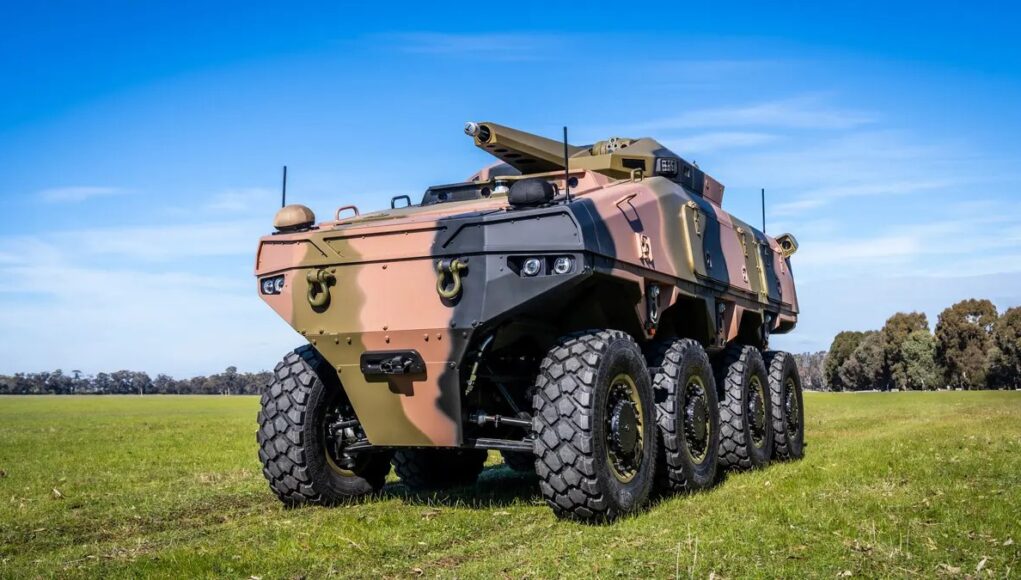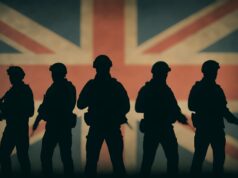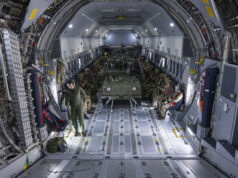BAE Systems Australia has introduced the Autonomous Tactical Light Armour System (ATLAS) Collaborative Combat Variant (CCV), an uncrewed ground vehicle designed to support military operations and reduce risks to soldiers.
The ATLAS CCV is an 8×8 modular vehicle capable of operating autonomously in both on- and off-road environments.
It is intended to complement crewed military assets, such as infantry fighting vehicles and main battle tanks, by performing tasks that would typically expose soldiers to danger.
The vehicle incorporates autonomous driving systems that enable it to avoid obstacles, plan routes, and make tactical decisions during missions. BAE Systems describes ATLAS as a cost-effective platform that can be upgraded and adapted to meet future operational requirements.
It is armed with the VANTAGE ATS, a medium-calibre turret system designed for uncrewed platforms. This system has a ‘human-in-the-loop’ feature that allows soldiers to maintain control over targeting.
The vehicle is also designed for ease of transport, fitting into a standard 20-foot ISO container for rapid deployment in various environments. BAE Systems notes that the vehicle could serve in logistical support roles, in addition to its combat and reconnaissance functions.
BAE Systems say they developed the ATLAS CCV in collaboration with industry partners, including Supacat, Valhalla Turrets, and Marand, drawing on expertise in both autonomous technology and armoured vehicles.
According to Andrew Gresham, Managing Director of Defence Delivery at BAE Systems Australia:
“We’ve developed the ATLAS vehicle to give soldiers the advantage on the modern battlefield. This has resulted in an autonomous platform that will deliver the dull, dirty and dangerous tasks expected in a combat environment. ATLAS will enable the Australian Army to be fit to fight in the littoral environment.
It will help the soldier outpace, out-manoeuvre and out-think conventional and unconventional threats. We have proven expertise in autonomous technologies, built on more than 30 years of complex autonomous projects. We’re excited that this is the first UGV of its kind to be developed in Australia and look forward to working with our industry partners to deliver this capability for our customers.”
The company notes that ATLAS will be further tested and evaluated for future applications.














It’s hight time the army stops counting boots as its main determinant of strength and starts thinking about effect. The army seems to be so far behind the other services on autonomous systems. The generals keep telling us we are facing the biggest threat since the Cold War yet their only solution seems to be increasingly expensive manned platforms with little more than incremental increases in firepower and accuracy. The only way china is going into a land war is with mass army’s of autonomous systems and right now there is every chance they win that fight.
Very interesting and apt. Even worse is the replacement of manned platforms with good firepower by those that are very expensive and have less firepower (Warrior being replaced by Boxer)…or the replacement of good but elderly platforms by far fewer platforms (once a fleet of 386 CR2s being replaced by 148 CR3s).
I remember my own time, long ago, as the only staff officer in the army responsible for robotic/unmanned vehicles and trying to persuade a sceptical army hierarchy of the merits of such technology.
Thanks for sharing, sounds like a tough job.
It was a long time ago, 1989 – 90. But yes, there was little interest then. Things have changed now. More interest but progress is still slow in getting UGVs in to service.
When you think the Germans were playing with unmanned anti tank vehicles in 1942 and the French created and used remote control vehicles for blowing up fortifications in 1916….took a long time to percolate through.
That is always the case Jonathon. Experienced generals have a tendency to prepared for the last war they fought, not the next. Young bucks (Graham back in the day) are far more open to change. Trying new state of the art kit. Willing to make adjustments to accommodate technology. When it comes to lessons, learning the hard way is still valid. But not very efficient and rather costly in lives. Ask the Russians and their Ukrainian cousins. Their learning curves have been somewhat exponential since 2014.
Total agree. The ability to destroy your opponents kit is what is important.
Important yes but killing highly trained, hard to replace specialists has an intrinsic value all of it’s own. Injured and recovering specialists become excellent training instructors with hands on experience. Rotting corpses, not so much. Additionally, destroyed kit has little impact on civilian moral. Dead sons and fathers or parts thereof in bags, really hit home.
It is best never to loose sight of the aims of warfare and the role of soldiers. Identify ones enemies. Locate, close with and kill them! Often described as the highest plane of human existance. That’s a little too deep for this Tom. It’s just necessary.
Point well made. Totally agree.
The land environment is far more complex than largely empty air space or sea. Presumably that is why, with the exception of remotely controlled mine clearance robots, there are no autonomous combat vehicles in service anywhere. Rand reported earlier this year on the reasons for the slow progress of development despite large amounts being spent on research.
I would expect that the first roles fully tested in service will be non lethal- reconnaissance, resupply, casualty evacuation.
I’m sure you are correct Peter. Have you seen “The Mule.” A quadruped robot that carries huge loads on it’s back and follows ground troops. Just like a well trained pack mule. It climbs difficult terrain like a mountain goat too. I wish I’d had some of them back in the day. Just imagine the possibilities.
If they can do gardening, count me in.
I think trampling nettles into submission would be extent of it. However, they do have a power outlet for a kettle or a small fridge to keep the ale cool.
Do you mean the Alpha Dog, for I assume by quadruped you are not referring to the more recent 6/8 wheel autonomous mule vehicles. The later seem much more promising as things and technology stand and are actively being developed for the US Army and Marines. But clearly they are more practical but less innovative and with lower ultimate expectations. Alpha Dog was discontinued some ten years ago, tests showed it to be too noisy, too complex and testing to maintain easily in the field and thus far too limiting. The only way the concept could be rehashed is as an electric (or new innovative quiet power system perhaps) and at the very least greater range than currently possible. Unlike factory or household robots it can’t simply go and plug itself in to a handy wall socket. New battery technology is coming but something like Alpha Dog, even though Boston Dynamics have gone all electric now, is some way from being practical in the field.
You are of course correct. I’ve seen videos of both and confused the names. If memory serves 🙄 the Alpha Dog was petrol driven but described as optionally electric. It certainly was memorable strutting about and resisting attempts to push it over. All while carrying the large packs of several US Marines. If or should I say when they perfect the technology, it has the potential to be as stealthy as a leopard.
I agree, the idea is excellent just needs the technology to catch up but that’s been the case for decades even centuries in ideas and inventions. Been away so haven’t read up on the supposed Tesla breakthrough with Aluminium Graphene battery technology and whether it’s as superior as claimed, have to take everything Musk and his fawning channels with a pinch of salt, but either way these sort of technologies are getting closer, so range and recharging may be solved enough to make things relatively practical in the field. Complexity is probably the other problem to ease reliability and ease of repair and with the advancement in humanoid robotic actuators, motors, joints and internal wiring to avoid wear now in full swing I do think the concept will make a comeback.
I do think the smaller robodogs will become a serious military feature this decade in all manner of roles, they are becoming relatively cheap and flexible even adopting wheels with legs to give the best of both Worlds, however the Chinese seem to be heading this research presently.
Agreed. Especially regarding the ChiComs leading the way. They may lag behind when it comes to good quality leading edge chip manufacture. However, when it comes to making things that are just good enough, they excel. Just good enough to function most of the time.
We should be thankful that the corruption inherent in their marxist based system, hinders quality control. It’s a culture where corruption/profiteering is expected as a perk. Their system simply would not function without it. The more powerful the individual, the easier it is for them to skim the cream. Few are more powerful than high ranking PLA generals. If they ever manage to purge corruption from the system, we should really worry.
It is the same for Russia and Ukraine. They may have cast off the shackles of communism but the culture of corruption remains. The road to full recovery is a long one.
‘ … there is every chance they win that fight.’
Where?
I completely agree about looking at delivering effects.
Likely Vietnam and SE Asia or Russia.
Hopefully it’s the latter 😀
Thanks Jim! Seriously, what would they gain if anything? Grabbing a chunk off Putin though! The thought!
Wow. A Tesla with a gun. What could possibly go wrong?
even worse an AI Tesla with a gun, just don’t give it access to X for Christ sake, it would take 30 seconds to decide the future of humanity….
😄😄
Could become President by present standards.